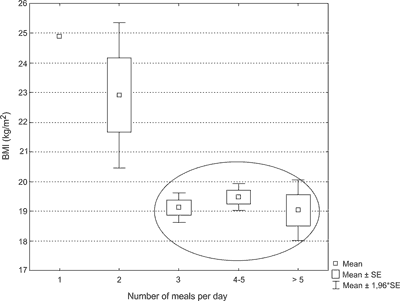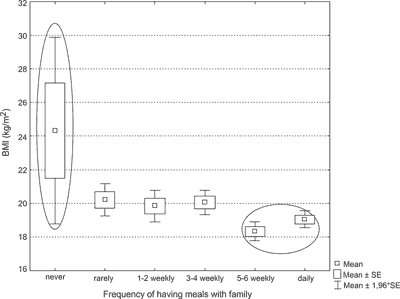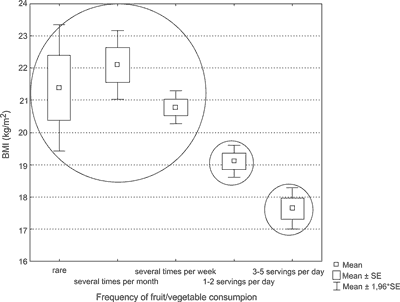© Borgis - Postępy Nauk Medycznych 9/2011, s. 724-731
*Katarzyna Wolnicka, Joanna Jaczewska-Schuetz
Weight status related to eating behaviors of school aged children in Warsaw
Stan odżywienia a nawyki żywieniowe wśród dzieci w wieku szkolnym z Warszawy
Department of Nutrition and Dietetics with the Clinic of Metabolic Diseases and Gastroenterology of the National Food and Nutrition Institute in Warsaw
Head: prof. Mirosław Jarosz, Ph.D., M.D.
Streszczenie
Wstęp. Podstawowym czynnikiem, decydującym o prawidłowym sposobie żywienia dziecka jest kształtowanie odpowiednich nawyków żywieniowych. Nieprawidłowe nawyki żywieniowe mogą prowadzić do występowania nadwagi i otyłości wśród dzieci i młodzieży.
Cel. Celem pracy było zbadanie wpływu nawyków żywieniowych na stan odżywienia dzieci w wieku 11-13 lat.
Materiał i metody. Badanie przeprowadzono w roku szkolnym 2009/2010 w pięciu losowo wybranych szkołach podstawowych na terenie Warszawy. Wśród 380 uczniów klas V i VI przeprowadzono ankietę dotyczącą wybranych nawyków żywieniowych oraz pomiary masy i wysokości ciała.
Wyniki. Stwierdzono, że dzieci spożywające przynajmniej 3 posiłki (p < 0,001; jednoczynnikowa ANOVA) oraz spożywające posiłki z rodziną minimum 5-6 razy w tygodniu (p < 0,001) miały istotnie niższe BMI od pozostałych. Przed wystąpieniem nadmiernej masy ciała może chronić spożywanie warzyw i owoców przynajmniej 1-2 razy dziennie; jeszcze silniejszym czynnikiem ochronnym może być spożywanie warzyw i owoców 3-5 razy dziennie (p = 0,007; test chi2). W grupie dzieci spożywających słodkie napoje codziennie znacznie częściej występowała otyłość niż w grupach pozostałych (p = 0,001; ANOVA).
Wnioski. Nieprawidłowe nawyki żywieniowe mogą wpływać na występowanie nadwagi i otyłości wśród badanych dzieci w wieku szkolnym. Prewencja nadwagi i otyłości u dzieci w wieku szkolnym powinna uwzględniać szeroko zakrojone działania edukacyjne na terenie szkoły oraz edukację żywieniową rodziców.
Summary
Introduction. Formation of proper eating habits is the main factor deciding about proper nutrition of a child. Less healthy dietary habits and poor food choices may be responsible for prevalence of overweight among children and adolescents.
Aim. This work was aiming to examine the impact of eating habits on the weight status of children aged 11-13.
Methods. A survey was conducted during the school year 2009/2010 in five primary schools, selected at random, in the area of Warsaw. A questionnaire on selected eating habits was answered by 380 pupils of the 5th and the 6th forms, and measurements of their weight and their height were taken.
Results. It was found that among children eating at least 3 meals a day (p < 0.001; ANOVA) as well as eating meals with the family at least 5-6 times a week (p < 0.001) prevalence of obesity was significantly lower. Consumption of fruits and vegetables at least 1-2 times per day significantly decreases prevalence of obesity. Stronger association was found if the consumption of fruits and vegetables was 3-5 times a day (p = 0.007). The group consuming sweet drinks every day has significantly higher BMI than the others (p = 0.001; ANOVA).
Conclusions. Selected eating habits appear to be associated with anthropometric characteristics in Polish primary school children. Prevention of overweight and obesity among school aged children shall include a broad spectrum of educational activities at school, as well as dietary education of parents.

INTRODUCTION
Obesity has a negative impact on health and growth not only in the childhood, but also in the adult life, increasing the risk of chronic non-infectious diseases and disabilities. Therefore, it is particularly important to prevent obesity already in the childhood.
Formation of human eating habits is a comprehensive process which starts in the early childhood. Many various factors impact eating habits of children; first of all children’s families, then their school and the surrounding environment: peers, fashion, commercials, etc. Eating habits impact nutrition, and hence, the weight status, both in the childhood and in the adult life (1). The overruling of bad eating habits and regular exercise seem to be the most effective way of overweight /obesity prevention.
Aim of the study
This work was aiming to examine impact of selected eating habits of primary school children on occurrence of overweight and obesity in Warsaw.
MATERIAL AND METHODS
A survey was conducted in the school year 2009/2010 in five primary schools, selected at random, in the area of Warsaw. It addressed 380 pupils aged 11-13, including 187 girls and 193 boys. The survey tool was a questionnaire, filled in by the children, with questions on the number of meals per day, the frequency of common meals with family, soft drinks, fruit and vegetables, the eating of breakfasts and fast food.
On the day when the survey was conducted, children were weighted and measured in the consulting room. The attendance rate on the survey day was at 80%.
It was found out that 11 children (2.89%) were underweight, 56 children (14.74%) were overweight, while 31 children (8.16%) were obese. The assessment was made according to the percentile chart of Body Mass Index developed by Palczewska and Niedźwiecka in the Institute of Mother and Child (IMD) in Warsaw.
RESULTS
It was found out that the majority of children had 4-5 meals per day. Only 13 children (3.4%) declared they had less than 3 meals per day. Children with proper weight declared less frequently that they had less than 3 meals per day as compared to children with overweight and obesity (1.4% vs 5.4% and 16.1% respectively) (tab. 1).
Table 1. Weight status and related eating behaviors among school-aged children from Warsaw.
| Obesity ≥ 95 centile (N = 31) | Overweight ≥ 85-95 centile (N = 56) | Normal ≥ 5-85 centile (N = 282) | Underweight < 5 centile (N = 11) | p |
| The number of meals | | | | | p < 0.001 |
| <3 (%) | 16.1 | 5.4 | 1.4 | 9.1 | |
| ≥3 (%) | 83.9 | 94.6 | 98.6 | 90.9 | |
| Eating common meals with family | | | | | p < 0.001 |
| everyday/5-6 x week (%) | 25.8 | 35.7 | 58.9 | 63.6 | |
| more rarely (%) | 74.2 | 64.3 | 41.1 | 36.4 | |
| Consumption of sweet drinks | | | | | p = 0.01 |
| everyday (%) | 29.0 | 8.9 | 9.6 | 9.1 | |
| more rarely than everyday (%) | 71.0 | 91.1 | 90.4 | 90.9 | |
| Consumption of fruit and vegetables | | | | | p = 0.007 |
| more rarely than everyday (%) | 64.5 | 35.7 | 33.7 | 18.2 | |
| 1-2 x day (%) | 25.8 | 41.1 | 42.5 | 27.3 | |
| 3-5 x day (%) | 9.7 | 23.2 | 23.8 | 54.5 | |
| Consumption of breakfast | | | | | p = 0.308 |
| everyday (%) | 77.4 | 80.4 | 72.0 | 90.9 | |
| more rarely (%) | 22.6 | 19.6 | 28.0 | 9.1 | |
| Consumption of fast food | | | | | P = 0.827 |
| everyday/several days per week (%) | 3.2 | 3.6 | 5.3 | 9.1 | |
| more rarely(%) | 96.8 | 96.4 | 94.7 | 90.9 | |
The average BMI related to the number of meals (5 categories) was statistically significant (p < 0.001; one way ANOVA). Groups which had at least 3 meals had significantly lower BMI than other groups (post-hoc Tukey test) (fig. 1). The number of meals affected BMI; that was not a linear correlation; a significantly lower BMI occurred on condition that 3 meals were eaten per day.

Fig. 1. Number of meals per day and BMI.
It was found out that 201 pupils (52.9%) had common meals with their families every day or almost every day. Children with proper weight declared more frequently that they had common meals with their families every day or 5-6 times per week as compared to children with overweight and obesity (58.9% vs 35.7% and 25.8% respectively, p < 0.001; Pearson chi-square test). Statistically significant differences were found out between average BMIs depending on the frequency of common meals with family (6 categories) (p < 0.001; one way ANOVA). The group that did not have common meals with family had a significantly higher BMI from other groups, while children who had common meals with family at least 5-6 times per week had a significantly lower BMI than other groups (Tukey post-hoc test) (fig. 2).

Fig. 2. Frequency of having meals with family.
The value of BMI was decreasing together with the growing number of common meals with family; it seems hence beneficial to have common meals with family at least 5-6 times per week; lack of such meals increases the risk of overweight.
It was found out that 136 pupils (35.8%) did not eat fruit and vegetables every day, 89 pupils (23.4%) ate fruit and vegetables 3-5 times per day, while 154 pupils (40.5%) ate fruit and vegetables 1-2 times per day. A significant difference in the weight status was found out in relation to consumption of fruit and vegetables (p = 0.007; Pearson chi-square test) (tab. 1). Children with obesity more frequently declared that they did not eat fruit and vegetables as compared to children with proper weight (64.5% vs 33.7%). The frequency of consumption of fruit and vegetables (5 categories) was significantly affecting BMI (continuous variable), (r = 0.500; p < 0.001; Spearman correlation coefficient). Differences between average BMIs depending on the frequency of consumption of fruit and vegetables were significant (p < 0.001; one way ANOVA) (fig. 3). Children who ate fruit and vegetables 3-5 times per day had significantly lower BMI as compared to children who ate fruit and vegetables 1-2 times per day, while those children had lower BMI than other (Tukey post-hoc test).

Fig. 3. Frequency of fruit/vegetable consumption.
It was hence established that the frequency of consumption of fruit and vegetables had significant impact on BMI; it was a linear correlation. Children can be protected from obesity with consumption of fruit and vegetables at least 1-2 times per day; consumption of fruit and vegetables 3-5 times per day is a stronger protection factor.
Powyżej zamieściliśmy fragment artykułu, do którego możesz uzyskać pełny dostęp.
Mam kod dostępu
- Aby uzyskać płatny dostęp do pełnej treści powyższego artykułu albo wszystkich artykułów (w zależności od wybranej opcji), należy wprowadzić kod.
- Wprowadzając kod, akceptują Państwo treść Regulaminu oraz potwierdzają zapoznanie się z nim.
- Aby kupić kod proszę skorzystać z jednej z poniższych opcji.
Opcja #1
29 zł
Wybieram
- dostęp do tego artykułu
- dostęp na 7 dni
uzyskany kod musi być wprowadzony na stronie artykułu, do którego został wykupiony
Opcja #2
69 zł
Wybieram
- dostęp do tego i pozostałych ponad 7000 artykułów
- dostęp na 30 dni
- najpopularniejsza opcja
Opcja #3
129 zł
Wybieram
- dostęp do tego i pozostałych ponad 7000 artykułów
- dostęp na 90 dni
- oszczędzasz 78 zł
Piśmiennictwo
1. Charzewska J, Rogalska-Niedźwiedź M: Potrzeby żywieniowe dzieci i młodzieży w wieku szkolnym. [W:] Zasady prawidłowego żywienia dzieci i młodzieży. (Ed.:) M. Jarosz, Warszawa, Wydawnictwo IŻŻ 2008; p. 239-54.
2. Kułaga Z, Litwin M, Zajączkowska M et al.: Porównanie wartości obwodów talii i bioder dzieci i młodzieży polskiej w wieku 7-18 lat z wartościami referencyjnymi dla oceny ryzyka sercowo-naczyniowego – wyniki wstępne projektu badawczego OLAF (PL0080). Stand Med 2008; V, 4, p. 473-85.
3. Chabros E, Charzewska J, Wajszczyk B et al.: Częstość występowania nadwagi i otyłości u młodzieży warszawskiej w wieku pokwitania. [W:] Charzewska J, Bergman P, Kaczanowski H. editors. Otyłość epidemią XXI wieku. Wydawnictwo AWF, Warszawa 2006; p. 54-62.
4. Mikiel-Kostyra K., Oblacińska A: Czynniki biologiczne, behawioralne i psychospołeczne kształtujące masę ciała (BMI) 13-latków. Warszawa 2010.
5. Ritchie L, Welk G, Styne D, Gerstein D: Family Environment and Pediatric Overweight: What Is a Parent to Do? J Am Diet Assoc 2005; 70-79.
6. Patric H, Nicklas TA: A review of family and social determinants of childrens eating patterns and diet quality. J Am Coll Nutr 2005; 24, 83-92.
7. Wajszczyk B, Charzewska J, Chabros E et al.: Jakościowa ocena sposobu żywienia młodzieży w wieku pokwitania. Probl Hig Epidemiol 2008; 89 (1), 85-89.
8. Czeczelewski J: Częstotliwość spożywania pierwszych i drugich śniadań przez uczniów klas IV-VI na przykładzie szkół podstawowych miasta Biała Podlaska. Rocz PZH 2001; 52, 321-28.
9. Bucholc M, Majsiak E, Łepecka-Klusek C: Masa ciała dziewcząt w okresie pokwitania w ocenie obiektywnej i subiektywnej. Ann Univ Maria Curie-Sklodowska 2003, Supp. XIII, 132-37.
10. Mędrela-Kudel E: Błędy żywieniowe dziewcząt w wieku gimnazjalnym, a ryzyko wystąpienia u nich zaburzeń odżywiania. Rocz PZH 2009; 60, 1, 39-42.
11. Mazur J, Wojnarowska B, Kołoło H: Zdrowie subiektywne, styl życia i środowisko psychospołeczne młodzieży szkolnej w Polsce. Raport techniczny z badań HBSC. Warszawa, IMD 2006.
12. Sandercock GRH, Voss C, Dye L: Association between habitual school-day breakfast consumption, body mass index, physical activity and cardiorespiratory fitness in English schoolchildren. Eur J Clin Nutr 2010; 64(10), 1086-1092.
13. Berkey C, Rockett H, Gillman M et al.: Longitudinal study of skipping breakfast and weight change in adolescents. Int J Obes Relat Metab Disord 2003; 27, 1258-66.
14. Ortega RM, Requejo AM, Lopez-Sobaler AM et al.: Difference in the breakfast habits of overweight/obese and normal weight schoolchildren. Int J Vit Nutr Res 1998; 68(2): 125-32.
15. Wolnicka K: Regularne spożywanie posiłków, pojadanie między posiłkami. [W:] Zasady prawidłowego żywienia dzieci i młodzieży. Ed.: M. Jarosz, Warszawa, Wydawnictwo IŻŻ 2008; p. 45-52.
16. Lairon D: Eating frequency and lipid metabolism. About eating frequency. Expert Meeting Nice, France 2003.
17. Oblacińska A, Jodkowska M et al.: Otyłość u polskich nastolatków epidemiologia, styl życia, samopoczucie. Warszawa, IMiD 2007.
18. Cullen KW, Baranowski T, Owens E et al.: Availability accessibility and preferences for fruit, 100% fruit juice and vegetables influence children´s dietary behavior. Health Educ Behav 2003; 30(5), 615-26.
19. Respondek W: Etiopatogeneza otyłości. Szkoła Interny dla Lekarza Rodzinnego 2010; 17, 5, 5004-07.
20. Komosińska K, Woynarowska B, Mazur J: Zachowania zdrowotne związane z żywieniem u młodzieży szkolnej w Polsce w latach 1990-1998 r. Żyw Człow Metab 2001; 28, 17-30.
21. Diagnoza stanu odżywienia, aktywności fizycznej i żywieniowych czynników ryzyka otyłości oraz przewlekłych chorób niezakaźnych. Ed.: M. Jarosz. Warszawa, Wydawnictwo IŻŻ 2006.
22. Rudolph T, Ruempler K, Schwedhelm E: Acute effects of various fast-food meals on vascular function and cardiovascular disease risk markers Hamburg Burger Trial Am J Clin Nutr 2007; 86: 334-40.
23. Gleason P, Suitor C: Children’s Diets in the Mid-1990s: Dietary Intake and Its Relationship with School Meal Participation. Alexandria, VA: US Departament of Agriculture, Food and Nutrition Service, Office of Analysis, Nutrition and Evaluation; 2001.
24. Ludwig DS, Peterson KE, Gortmaker SL: Relation between consumption of sugar-sweetened drinks and childhood obesity: a prospective observational analysis. Lancet 2001; 357: 505-08.
25. James J, Thomas P, Cavan D et al.: Preventing childhood obesity by reducing consumption of carbonated drinks: cluster randomized controlled trial. BMJ 2007; 328: 1237.
26. Harnack L, Stang J, Story M: Soft drink consumption among US children and adolescents: nutritional consequences. J Am Diet Assoc 99 (4), 436-41.
27. Szczepańska E, Piórkowska K, Niedworok E et al.: Konsumpcja słodyczy i napojów wysokosłodzonych w aspekcie występowania otyłości na przykładzie dzieci zamieszkujących obszary miejskie i wiejskie. Endokrynol Otył Zab Przem Mat 2010; 6, 2: 78-84.
28. Woynarowska B, Mazur J: Organizacja żywienia uczniów w szkole a profilaktyka nadwagi i otyłości. Zdr Publ 2008; 118(2), 132-37.
29. Waśkiewicz A, Słońska Z, Drygas W: Czy zachowania zdrowotne polskich nastolatków mogą sprzyjać powstawaniu nadwagi i otyłości? Rocz PZH 2009; 60, 4, 341-45.
30. Gillman M, Rifas-Shiman S, Frazier L et al.: Family dinner and diet quality among older children and adolescent. Arch Fam Med 2000; 9, 235-40
31. Woodruff SJ, Hanning RM: Association Between Family Dinner Frequency and Specific Food Behaviors Among Grade Six, Seven and Eight Students from Ontario and Nova Scotia J Adolesc Health 2009; 44, 431-36.



